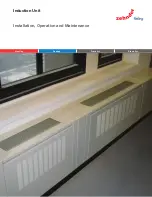
2
Introduction
Important notes, please read carefully before proceeding with installation
The SmartMat brand
Thank you for choosing the SmartMat underfloor
heating mat from our range of electric underfloor
heating solutions.
The SmartMat range has been manufactured to
surpass all current industry standards and comes
with a lifetime warranty.
SmartMat underfloor heating mat
The SmartMat underfloor heating mat has a self-
adhesive fibre glass backing mesh with an ultra-thin
twin conductor 3mm heating cable pre attached,
ensuring minimal increase to the existing floor
height. The function of the matting system is to
provide a warm floor.
Superior product design ensures a speedy
installation with an even heat across the complete
floor surface, whilst allowing unlimited adjustment
of the heating element to suit irregular formats.
The SmartMat matting system is available in three
output types:
Tools needed for installation
You will require the following items to install and
test the floor warming systems.
• Tape measure, drawing pad and pencil
• Utility knife, scissors
• Cable strippers, screw driver
• Resistance tester (multimeter), insulation
resistance tester
You will also need the appropriate tools and materials
to install your finished floor surface; these will probably
include products like self-levelling compound,
insulated backer board, notched tile trowel and various
other tools and materials for your specific project.
Dos & Don’ts
Do
Carefully read this instruction manual before starting
your installation and follow the testing procedure on
page 7. Throughout your installation:
• Take time to plan your mat layout considering all
obstacles e.g. kitchen cupboards, bathroom sinks etc.
Ensure the mat will fit before laying.
• Use flexible tile adhesives and grouting materials.
• Ensure the floor sensor thermostat is inserted within
the flexible tube provided and installed between two
heating elements, with the floor end of the flexible
tube effectively sealed (to ensure easy removal of floor
sensor if required after installation). See page 3.
• Maintain a minimum of 50mm between the heating
element runs.
• Take care not to damage the heating element and cold
tail whilst tiling.
• Ensure all the orange heating element is covered
with a flexible self-levelling compound or flexible tile
adhesive.
• Make certain there are no air gaps underneath tiled
areas or between heating element runs.
• Ensure the floor surface is prepared correctly before
installation. See note on page 4.
• When using more than one mat from a single supply,
cold tails must be connected in parallel.
Don’t
• Cut or shorten the orange heating cable.
• Cross or touch the orange heating cables together.
Switch on your under floor heating system for a
minimum of 7 days after tiling to allow correct curing
of tile adhesives and grouts.
• Connect the heating element to the power supply
whilst still rolled up.
• Leave rolled up surplus sections of mat under kitchen
units or bath spaces.
• Commence installation of your floor surface before
testing your mat. See page 7.
• Tile over damaged or twisted cables.
• Install under kitchen units or permanent fixtures such
as baths
100 watts per m2
(for use with timber
floor substrates e.g.
plywood etc).
150 watts per m2
(for use with concrete
floor substrates e.g. sand
cement screed, insulated
backer boards etc).
200 watts per m2
(for use where a
higher wattage
output is required e.g.
conservatory).






























